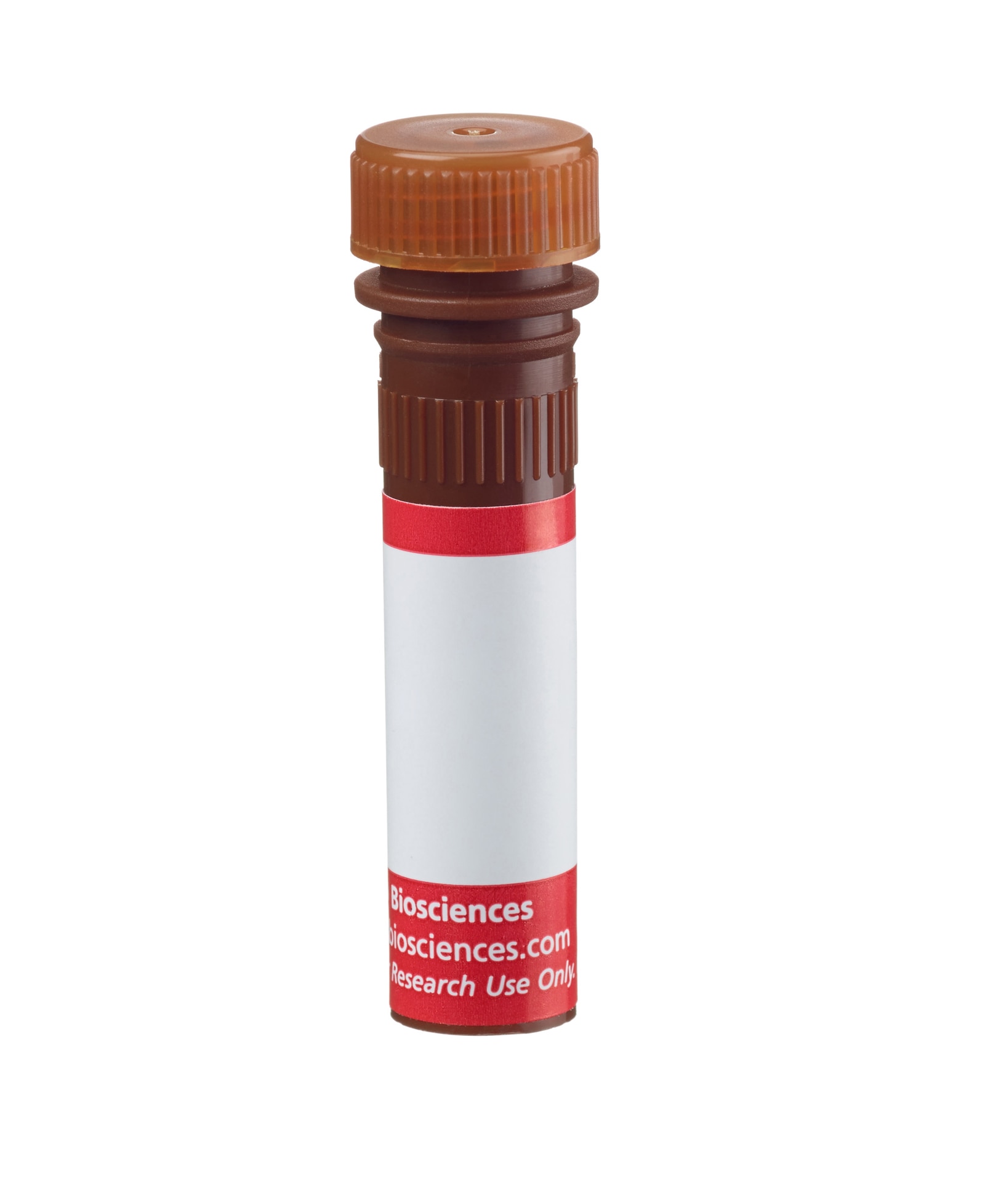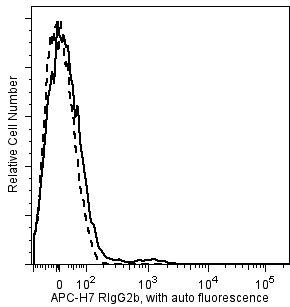-
Your selected country is
Middle East / Africa
- Change country/language
Old Browser
This page has been recently translated and is available in French now.
Looks like you're visiting us from {countryName}.
Would you like to stay on the current country site or be switched to your country?




Two-color analysis of the expression of CD117 on mouse bone marrow cells. A single-cell suspension of C57BL/6 bone marrow was simultaneously stained with FITC-conjugated anti-mouse CD45R/B220 RA3-6B2 (clone RA3-6B2, Cat. No. 553087/553088, both panels) and APC-H7 -conjugated 2B8 (Cat. no. 560185, right panel) or APC-H7 rat IgG2b isotype control (clone A95-1, Cat. No. 560200) monoclonal antibodies. Flow cytometry was performed on a BD™ LSR II flow cytometry system.


BD Pharmingen™ APC-H7 Rat anti-Mouse CD117

Regulatory Status Legend
Any use of products other than the permitted use without the express written authorization of Becton, Dickinson and Company is strictly prohibited.
Preparation And Storage
Product Notices
- Since applications vary, each investigator should titrate the reagent to obtain optimal results.
- Please refer to www.bdbiosciences.com/us/s/resources for technical protocols.
- BD APC-H7 is a tandem conjugate and an analog of APC-Cy7 with the same spectral properties. It has decreased intensity but it is engineered for greater stability and less spillover in the APC channel and consequently offers better performance than APC-Cy7. It has an absorption maximum of approximately 650 nm. When excited by light from a red laser, the APC fluorochrome can transfer energy to the cyanine dye, which then emits at a longer wavelength. The resulting fluorescent emission maximum is approximately 767 nm. BD recommends that a 750-nm longpass filter be used along with a red-sensitive detector such as the Hamamatsu R3896 PMT. As with APC-Cy7 special filters are required when using APC-H7 in conjunction with APC. Note: Although our APC-H7 products demonstrate higher lot-to lot consistency than other APC tandem conjugate products, and every effort is made to minimize the lot-to-lot variation in residual emission from APC, it is strongly recommended that every lot be tested for differences in the amount of compensation required and that individual compensation controls are run for each APC-H7 conjugate.
- Although BD APC-H7 is engineered to minimize spillover to the APC channel and is more stable and less affected by light, temperature, and formaldehyde-based fixatives, compared to other APC-cyanine tandem dyes, it is still good practice to minimize as much as possible, any light, temperature and fixative exposure when working with all fluorescent conjugates.
- For fluorochrome spectra and suitable instrument settings, please refer to our Multicolor Flow Cytometry web page at www.bdbiosciences.com/colors.
- Caution: Sodium azide yields highly toxic hydrazoic acid under acidic conditions. Dilute azide compounds in running water before discarding to avoid accumulation of potentially explosive deposits in plumbing.
Companion Products


The 2B8 monoclonal antibody specifically binds to CD117 (c-Kit), a transmembrane tyrosine-kinase receptor that is encoded by the Kit gene (formerly dominant white spotting, W). The c-Kit ligand (also known as steel factor, stem cell factor, and mast cell growth factor) encoded by the Kit1 gene (formerly steel, SI), is a co-mitogen for hematopoietic stem cells, myeloerythroid progenitors and a mast-cell differentiation factor. The KitW and Kit1SI mutant alleles have similar pleiotropic effects on the development of melanocytes, germ cells, and the hematopoietic system. In the adult bone marrow, CD117 is expressed on hematopoietic progenitor cells, including CD90 (Thy-1) low, TER-119-, CD45R/B220-, CD11b (Mac-1)-, Ly-6G (Gr-1)-, CD4-, CD8-, and Sca-1 (Ly-6A/E)+ multipotent hemotopoietic stem cells, progenitors committed to myeliod and/or erythroid lineages, and precursors of B and T lymphocytes. This widespread expression of CD117 in hematopoietic precursors is consistent with the participation of c-Kit and its ligand in the regulation of several hematopoietic lineages. Intrathymic expression of c-Kit and c-Kit ligand suggest that CD117 is also involved in the regulation of some events during the development of T lymphocytes. CD117 is also expressed by mast cells and by dendritic cells found in the periarteriolar lymphocytoc sheaths (T-cell areas) of splenic white pulp. The mAb 2B8 reportedly does not block the action of c-Kit. This clone 2B8 had been reported to cross-react with rat.

Development References (15)
-
Anderson DM, Lyman SD, Baird A, et al. Molecular cloning of mast cell growth factor, a hematopoietin that is active in both membrane bound and soluble forms. Cell. 1990; 63(1):235-243. (Biology). View Reference
-
Austen KF, Boyce JA. Mast cell lineage development and phenotypic regulation. Leuk Res. 2001; 25(7):511-518. (Biology). View Reference
-
Domen J, Weissman IL. Hematopoietic stem cells need two signals to prevent apoptosis; BCL-2 can provide one of these, Kitl/c-Kit signaling the other. J Exp Med. 2000; 192(12):1707-1718. (Biology). View Reference
-
Fadini GP, Sartore S, Schiavon M, et al. Diabetes impairs progenitor cell mobilisation after hindlimb ischaemia-reperfusion injury in rats. Diabetologia. 2006; 49(12):3075-3084. (Clone-specific). View Reference
-
Godfrey DI, Zlotnik A. Control points in early T-cell development. Immunol Today. 1993; 14(11):547-553. (Biology). View Reference
-
Huang E, Nocka K, Beier DR, et al. The hematopoietic growth factor KL is encoded by the Sl locus and is the ligand of the c-kit receptor, the gene product of the W locus. Cell. 1990; 63(1):225-233. (Biology). View Reference
-
Ikuta K, Weissman IL. Evidence that hematopoietic stem cells express mouse c-kit but do not depend on steel factor for their generation. Proc Natl Acad Sci U S A. 1992; 89(4):1502-1506. (Immunogen: Flow cytometry, Immunoprecipitation). View Reference
-
Kondo M, Weissman IL, Akashi K. Identification of clonogenic common lymphoid progenitors in mouse bone marrow. Cell. 1997; 91(5):661-672. (Biology). View Reference
-
Lian Z, Toki J, Yu C, et al. Intrathymically injected hemopoietic stem cells can differentiate into all lineage cells in the thymus: differences between c-kit+ cells and c-kit < low cells. Stem Cells. 1997; 15(6):430-436. (Biology). View Reference
-
Mirmonsef P, Shelburne CP, Fitzhugh Yeatman C 2nd, Chong HJ, Ryan JJ. Inhibition of Kit expression by IL-4 and IL-10 in murine mast cells: role of STAT6 and phosphatidylinositol 3'-kinase. J Immunol. 1999; 163(5):2530-2539. (Biology). View Reference
-
Ogawa M, Matsuzaki Y, Nishikawa S, et al. Expression and function of c-kit in hemopoietic progenitor cells. J Exp Med. 1991; 174(1):63-71. (Biology). View Reference
-
Pulendran B, Lingappa J, Kennedy MK, et al. Developmental pathways of dendritic cells in vivo: distinct function, phenotype, and localization of dendritic cell subsets in FLT3 ligand-treated mice. J Immunol. 1997; 159(5):2222-2231. (Biology). View Reference
-
Rodewald HR, Kretzschmar K, Swat W, Takeda S. Intrathymically expressed c-kit ligand (stem cell factor) is a major factor driving expansion of very immature thymocytes in vivo. Immunity. 1995; 3(3):313-319. (Biology). View Reference
-
Valent P. The riddle of the mast cell: kit(CD117)-ligand as the missing link?. Immunol Today. 1994; 15(3):111-114. (Biology). View Reference
-
Zsebo KM, Wypych J, McNiece IK, et al. Identification, purification, and biological characterization of hematopoietic stem cell factor from buffalo rat liver--conditioned medium. Cell. 1990; 63(1):195-201. (Biology). View Reference
Please refer to Support Documents for Quality Certificates
Global - Refer to manufacturer's instructions for use and related User Manuals and Technical data sheets before using this products as described
Comparisons, where applicable, are made against older BD Technology, manual methods or are general performance claims. Comparisons are not made against non-BD technologies, unless otherwise noted.
For Research Use Only. Not for use in diagnostic or therapeutic procedures.
Report a Site Issue
This form is intended to help us improve our website experience. For other support, please visit our Contact Us page.